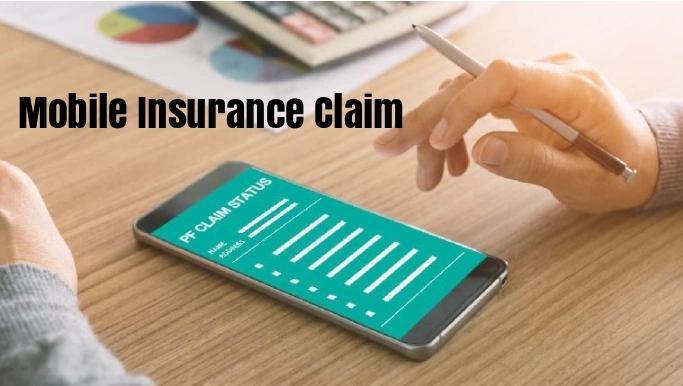A mobile insurance claims is the process of filing and managing an insurance claim using a mobile device, such as a smartphone or tablet. It allows policyholders to initiate and complete the claims process entirely through a mobile application or mobile-friendly website, without the need for traditional paper forms or in-person interactions.
Mobile insurance claims can cover various types of insurance policies, including auto, home, health, and life insurance. Common claims that can be filed via mobile include:
- Auto Insurance Claims: Report accidents, submit photos of vehicle damage, and provide details about the incident directly from the scene.
- Home Insurance Claims: Document property damage, theft, or natural disasters by uploading photos and videos, and provide details about the loss.
- Health Insurance Claims: Submit medical bills, prescription information, and other healthcare-related expenses for reimbursement.
- Travel Insurance Claims: File claims for trip cancellations, delays, lost luggage, or medical emergencies while traveling.
The primary difference between mobile insurance claims and traditional claims lies in the convenience and accessibility offered by mobile platforms. Instead of relying on phone calls, paper forms, or in-person visits, policyholders can initiate and manage the entire claims process from their mobile devices, anywhere and at any time. This streamlined approach saves time, reduces paperwork, and provides a more user-friendly experience.
Benefits of Mobile Insurance Claims
Mobile insurance claims offer numerous benefits to policyholders, making the process of filing a claim more convenient, faster, and easier to document. One of the primary advantages is the sheer convenience factor, as you can initiate a claim anytime, anywhere, directly from your smartphone or tablet. No more waiting on hold or scheduling appointments during business hours – mobile claims allow you to take action immediately after an incident occurs.
Another significant benefit is the potential for faster processing times. By submitting claims digitally with photos, videos, and details captured on the spot, insurers can often expedite the review process compared to traditional paper-based methods. This streamlined approach can lead to quicker resolution and payout of approved claims.
Mobile claims also simplify the documentation process. Instead of filling out lengthy forms or gathering various documents, you can capture detailed information, including photos and videos of the damage or incident, directly through your mobile device. This not only makes the process more straightforward but also provides insurers with more comprehensive and accurate evidence, reducing the need for additional follow-ups or information requests.
Overall, the convenience, faster processing times, and easier documentation offered by mobile insurance claims can significantly enhance the overall claims experience for policyholders, making it a valuable and time-saving option in today’s digital age.
How Mobile Claims Work
The process of filing a mobile insurance claim is designed to be quick, convenient, and hassle-free for policyholders. Here’s a step-by-step breakdown of how it typically works:
Initiate the Claim:
After an insured event occurs, such as an accident or theft, the policyholder can initiate the claim process through their insurance provider’s mobile app or website. This often involves filling out an online form with details about the incident and the damages incurred.
Upload Documentation:
Depending on the type of claim, the policyholder may be required to upload supporting documentation, such as photographs of the damage, repair estimates, or police reports. Many mobile apps and websites have built-in features that allow users to capture and upload photos directly from their smartphones.
Claim Processing:
Once the claim has been submitted, the insurance company will review the information and documentation provided. They may request additional information or clarification if necessary.
Damage Assessment:
For certain types of claims, such as vehicle accidents, the insurance company may arrange for a virtual or in-person damage assessment. This can involve a video call or a visit from an adjuster to inspect the damages and estimate repair costs.
Claim Approval or Denial:
After reviewing all the information, the insurance company will either approve or deny the claim. If approved, they will provide details on the coverage amount and any deductibles that apply.
Payment or Repair Arrangements:
If the claim is approved, the insurance company will typically offer options for receiving payment or arranging for repairs. This may involve direct payment to the policyholder, payment to a repair facility, or the issuance of a rental car or temporary housing if needed.
Throughout the process, policyholders can track the status of their claim through the mobile app or website. Many insurers also offer live chat or customer support options within the app for any questions or assistance needed.
Types of Claims Handled via Mobile
Auto Insurance Claims
With mobile apps, policyholders can easily file auto insurance claims for accidents, vandalism, or weather-related damage right from the scene. They can capture photos of the damage, provide details of the incident, and even schedule a repair estimate or rental car service. This streamlined process eliminates the need for paperwork and lengthy phone calls.
Home Insurance Claims
Mobile apps allow homeowners to quickly report and document claims for events like fire, theft, or natural disasters. Users can upload photos and videos of the damage, describe the incident, and even initiate the claims process with their insurance provider. This convenient method ensures timely reporting and efficient claim processing.
Health Insurance Claims
Mobile health insurance apps enable policyholders to manage their medical claims on-the-go. They can submit claims for doctor visits, hospital stays, or prescription medications by uploading relevant documents and receipts. Some apps even offer real-time claim status updates and the ability to track reimbursements.
Life Insurance Claims
While less common, some life insurance companies now allow beneficiaries to initiate claims through mobile apps. This involves providing necessary documentation, such as death certificates and policy information. The mobile platform streamlines the process, ensuring timely claim submission and processing during a difficult time.
Mobile Claim Documentation

With mobile insurance claims, you can easily document your claim using your smartphone’s camera. Photos and videos serve as crucial evidence, allowing you to capture detailed visuals of the damage or incident. Simply snap clear, well-lit photos from multiple angles and record short videos if necessary.
Many mobile claim apps also enable you to electronically sign documents right from your device, streamlining the process. You can review and digitally sign claim forms, authorizations, or any other required paperwork without the need for printing or scanning.
Additionally, these apps typically provide a secure way to upload supplementary documents, such as repair estimates, police reports, or medical records. You can seamlessly attach these files to your claim, ensuring that all relevant information is readily available for the claims adjuster to review.
The convenience of mobile claim documentation eliminates the hassle of physically mailing or faxing paperwork, making the entire process more efficient and eco-friendly. With just a few taps on your smartphone, you can comprehensively document your claim and expedite the resolution process.
Security and Privacy Concerns
When filing insurance claims through a mobile app or website, data security and privacy are paramount concerns. Insurers must implement robust security measures to protect sensitive personal and financial information from unauthorized access, theft, or misuse.
Data Encryption: All data transmitted between the user’s device and the insurer’s servers should be encrypted using strong encryption algorithms like AES-256 or higher. This ensures that even if the data is intercepted, it remains unreadable and secure.
Authentication: Mobile claim platforms should employ multi-factor authentication (MFA) to verify the user’s identity. This can include a combination of passwords, biometrics (fingerprint or facial recognition), and one-time passcodes sent to a registered device or email.
Regulatory Compliance: Insurance companies must comply with various data protection regulations, such as the General Data Protection Regulation (GDPR) in the European Union and the Health Insurance Portability and Accountability Act (HIPAA) in the United States. These regulations mandate strict security controls and privacy practices to safeguard customers’ personal and health information.
Mobile claim platforms should also have robust access controls, limiting data access only to authorized personnel on a need-to-know basis. Regular security audits, penetration testing, and vulnerability assessments should be conducted to identify and address potential security weaknesses.
Insurers must transparently communicate their data privacy policies and obtain explicit consent from users regarding the collection, use, and sharing of their personal information. Customers should have the option to review and manage their data, as well as request its deletion if desired.
By implementing strong security measures and adhering to privacy regulations, insurers can build trust with their customers and ensure the confidentiality and integrity of sensitive data throughout the mobile claims process.
Filing a Mobile Claim: Tips
Filing a mobile insurance claim can be a smooth and efficient process if you follow some best practices. Here are some tips to keep in mind:
Prepare Documentation in Advance
Before starting the claim process, gather all the necessary documentation and information. This may include:
- Policy details and numbers
- Details of the incident (date, time, location, etc.)
- Photos or videos of the damage
- Contact information of any witnesses or parties involved
- Repair estimates or invoices (if applicable)
Having this information ready will streamline the process and ensure you don’t miss any important details.
Utilize Mobile App Features
Most insurance companies offer user-friendly mobile apps designed to simplify the claims process. Familiarize yourself with the app’s features and functionalities, such as:
- Uploading photos and videos
- Entering claim details and descriptions
- Tracking claim status
- Communicating with adjusters or customer service
Using the app efficiently can save you time and effort, and ensure your claim is processed accurately.
Follow Up Regularly
After submitting your claim, follow up regularly to check on its status and ensure it’s progressing smoothly. Don’t hesitate to reach out to your insurance provider if you have any questions or concerns.
Additionally, promptly respond to any requests for additional information or documentation from the insurance company. Delays in providing the required information can slow down the claims process.
Be Thorough and Honest
When filing a mobile claim, it’s crucial to provide accurate and complete information. Omitting details or providing false information can lead to claim denials or legal consequences.
Describe the incident and damages as accurately as possible, and don’t exaggerate or downplay any details. Honesty and transparency will help ensure a smoother claims process and a fair settlement.
Mobile Claims and Customer Satisfaction

Mobile claims have significantly improved customer satisfaction in the insurance industry. According to a survey by J.D. Power, insurers with robust mobile claim capabilities reported a 20% higher customer satisfaction rate compared to those without mobile options. The convenience of initiating and managing claims from a smartphone or tablet has been a game-changer for policyholders.
Customer testimonials highlight the ease and efficiency of mobile claims. “I was in a minor fender bender, and within minutes, I had reported the incident, uploaded photos, and received a claim number – all from my phone,” said Sarah, a customer of a leading auto insurer. “The process was seamless, and I didn’t have to wait on hold or visit an office.”
Mobile claims have also positively impacted customer loyalty. A study by Accenture found that policyholders who used mobile claims were 57% more likely to renew their policies and recommend their insurer to others. The streamlined experience and transparency provided by mobile claims have fostered trust and strengthened the customer-insurer relationship.
Furthermore, mobile claims have reduced cycle times and operational costs for insurers, enabling them to provide better service and pricing to customers. According to industry data, mobile claims are processed up to 30% faster than traditional claims, leading to quicker resolution and increased customer satisfaction.
Overall, the integration of mobile technology into the claims process has been a win-win for both insurers and policyholders. As more customers embrace the convenience of mobile claims, insurers that prioritize this channel are likely to see increased customer satisfaction, loyalty, and retention.
Future of Mobile Insurance Claims
The future of mobile insurance claims is poised for significant advancements driven by emerging technologies and evolving industry trends. As smartphones become more powerful and ubiquitous, insurers are leveraging cutting-edge innovations to streamline the claims process further and enhance the customer experience.
One of the most promising developments is the integration of augmented reality (AR) and virtual reality (VR) into mobile claim applications. These immersive technologies enable policyholders to capture detailed visual information about damages, facilitating more accurate assessments and faster claim resolutions. For instance, AR overlays can provide real-time guidance on documenting evidence, while VR can recreate accident scenes for thorough investigations.
Furthermore, the proliferation of 5G networks and the Internet of Things (IoT) is set to revolutionize mobile claims. Connected devices, such as smart home sensors and vehicle telematics, can automatically transmit real-time data to insurers, expediting the claims process and reducing the potential for fraud. This seamless data exchange will enable insurers to proactively initiate claims and offer personalized services based on individual circumstances.
Machine Learning
Artificial intelligence (AI) and machine learning (ML) are also expected to play a pivotal role in the future of mobile insurance claims. Advanced algorithms can analyze vast amounts of data, including images, videos, and sensor readings, to detect patterns, assess damages, and even predict potential claims before they occur. This predictive capability will allow insurers to implement proactive measures, mitigating risks and minimizing losses.
Moreover, the integration of mobile claims with digital payment systems and blockchain technology is anticipated to streamline the claims settlement process. Secure and transparent payment mechanisms will enable faster reimbursements, while blockchain’s decentralized ledger will ensure tamper-proof record-keeping and enhanced trust between insurers and policyholders.
As the insurance industry continues to embrace digital transformation, mobile insurance claims will become an integral part of the customer experience. Insurers that prioritize innovation, leverage emerging technologies, and adapt to changing consumer preferences will gain a competitive edge in the evolving insurance landscape.


